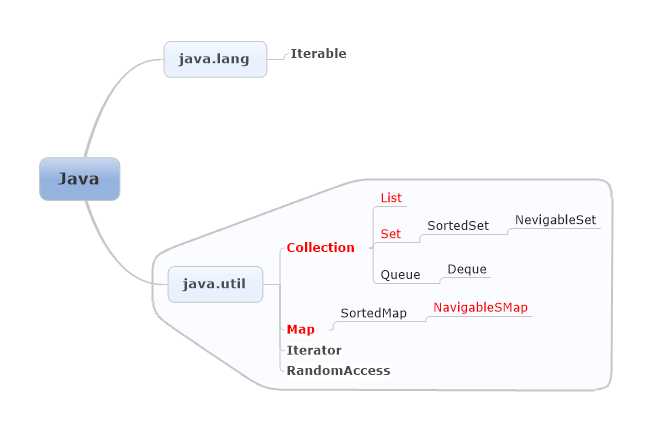java 里的 Collection接口有啥作用
Posted
tags:
篇首语:本文由小常识网(cha138.com)小编为大家整理,主要介绍了java 里的 Collection接口有啥作用相关的知识,希望对你有一定的参考价值。
Collection是集合类接口,是所有集合类的,父类,提供了关于集合的一些操作,如插入、删除、判断一个元素是否其成员、遍历等 参考技术A Collection是集合类接口,是所有集合类的,父类,提供了关于集合的一些操作,如插入、删除、判断一个元素是否其成员、遍历等。 参考技术B Collection是集合类接口,是所有集合类的,父类,提供了关于集合的一些操作,如插入、删除、判断一个元素是否其成员、遍历等。 参考技术C Collection是集合类接口,在实际开发中不用它,是使用它的子接口 list 、set 。 参考技术D java里的Collection接口是单列集合的接口类,它包含了单列集合的一系列共同操作,比如插入insert、删除delete、判断一个元素是否其成员、遍历iterator等。实现Collection接口就可以创建出一个具备单列集合特性的类。java中为了存储一组类型相同的数据,出现了数组的语法,当需要存储一组不同的对象时,提出了集合的概念,然后把集合中一些共同的操作提取了出来编写为接口,整个过程体现了java语言的封装、继承和多态的特性。
IteratorIterable接口的使用及详解
Java集合类库将集合的接口与实现分离。同样的接口,可以有不同的实现。
Java集合类的基本接口是Collection接口。而Collection接口必须实现Iterator接口。
以下图表示集合框架的接口,java.lang以及java.util两个包里的。其他部分可以从左向右看,比如Collection的Subinterfaces有List,Set以及Queue等。
package java.util;
/**
* An iterator over a collection. Iterator takes the place of Enumeration in
* the Java collections framework. Iterators differ from enumerations in two
* ways: <ul>
* <li> Iterators allow the caller to remove elements from the
* underlying collection during the iteration with well-defined
* semantics.
* <li> Method names have been improved.
* </ul><p>
*
* This interface is a member of the
* <a href="{@docRoot}/../technotes/guides/collections/index.html">
* Java Collections Framework</a>.
*
* @author Josh Bloch
* @version %I%, %G%
* @see Collection
* @see ListIterator
* @see Enumeration
* @since 1.2
*/
public interface Iterator<E> {
/**
* Returns <tt>true</tt> if the iteration has more elements. (In other
* words, returns <tt>true</tt> if <tt>next</tt> would return an element
* rather than throwing an exception.)
*
* @return <tt>true</tt> if the iterator has more elements.
*/
boolean hasNext();
/**
* Returns the next element (每一次迭代,the next element就是index为0的元素)in the iteration.
*
* @return the next element in the iteration.
* @exception NoSuchElementException iteration has no more elements.
*/
E next();
/**
*
* Removes from the underlying collection the last element returned by the
* iterator (optional operation). This method can be called only once per
* call to <tt>next</tt>. The behavior of an iterator is unspecified if
* the underlying collection is modified while the iteration is in
* progress in any way other than by calling this method.
*
* @exception UnsupportedOperationException if the <tt>remove</tt>
* operation is not supported by this Iterator.
* @exception IllegalStateException if the <tt>next</tt> method has not
* yet been called, or the <tt>remove</tt> method has already
* been called after the last call to the <tt>next</tt>
* method.
*/
void remove();
}
以下例子是利用了Iterator接口的着三个方法,实现遍历ArrayList<String>类型。
一开始迭代器在所有元素的左边,调用next()之后,迭代器移到第一个和第二个元素之间,next()方法返回迭代器刚刚经过的元素。
hasNext()若返回True,则表明接下来还有元素,迭代器不在尾部。
remove()方法必须和next方法一起使用,功能是去除刚刚next方法返回的元素。
import java.util.ArrayList;
import java.util.Collection;
import java.util.Iterator;
public class ForEachDemo {
public static void main(String... arg) {
Collection<String> a = new ArrayList<String>();
a.add("Bob");
a.add("Alice");
a.add("Lisy");
Iterator<String> iterator = a.iterator();
while (iterator.hasNext()) {
String ele = iterator.next();
System.out.println(ele);//Bob Alice Lisy
}
System.out.println(a);//[Bob, Alice, Lisy]
iterator = a.iterator();
iterator.next();
iterator.remove();
System.out.println(a);//[Alice, Lisy]
}
}
package java.lang;
import java.util.Iterator;
/** Implementing this interface allows an object to be the target of
* the "foreach" statement.
* @since 1.5
*/
public interface Iterable<T> {
/**
* Returns an iterator over a set of elements of type T.
*
* @return an Iterator.
*/
Iterator<T> iterator();
}
for-each循环可以与任何实现了Iterable接口的对象一起工作。
而Collection接口扩展了Iterable接口,故标准类库中的任何集合都可以使用for-each循环。
Collection接口
此接口的方法
public interface Collection<E>{......}
| Modifier and Type | Method and Description |
|---|---|
boolean |
add(E e)
Ensures that this collection contains the specified element (optional operation).
|
boolean |
addAll(Collection<? extends E> c)
Adds all of the elements in the specified collection to this collection (optional operation).
|
void |
clear()
Removes all of the elements from this collection (optional operation).
|
boolean |
contains(Object o)
Returns true if this collection contains the specified element.
|
boolean |
containsAll(Collection<?> c)
Returns true if this collection contains all of the elements in the specified collection.
|
boolean |
equals(Object o)
Compares the specified object with this collection for equality.
|
int |
hashCode()
Returns the hash code value for this collection.
|
boolean |
isEmpty()
Returns true if this collection contains no elements.
|
Iterator<E> |
iterator()
Returns an iterator over the elements in this collection.
|
boolean |
remove(Object o)
Removes a single instance of the specified element from this collection, if it is present (optional operation).
|
boolean |
removeAll(Collection<?> c)
Removes all of this collection‘s elements that are also contained in the specified collection (optional operation).
|
boolean |
retainAll(Collection<?> c)
Retains only the elements in this collection that are contained in the specified collection (optional operation).
|
int |
size()
Returns the number of elements in this collection.
|
Object[] |
toArray()
Returns an array containing all of the elements in this collection.
|
<T> T[] |
toArray(T[] a)
Returns an array containing all of the elements in this collection; the runtime type of the returned array is that of the specified array.
|
因为其中有一个返回值为Iterator<E>类型的iterator()方法,所以,Collection接口必须实现Iterator接口
实现Collection接口的每一个类都要实现以上众多方法,但开发者自己实现很麻烦。所以java提供了AbstractCollection类来编写具体的类。
java.util
Interface Collection<E>
- All Superinterfaces:
- Iterable<E>
- All Known Subinterfaces:
- BeanContext, BeanContextServices, BlockingDeque<E>, BlockingQueue<E>, Deque<E>, List<E>, NavigableSet<E>, Queue<E>, Set<E>,SortedSet<E>
- All Known Implementing Classes:
- AbstractCollection, AbstractList, AbstractQueue, AbstractSequentialList, AbstractSet, ArrayBlockingQueue, ArrayDeque, ArrayList, AttributeList, BeanContextServicesSupport, BeanContextSupport, ConcurrentLinkedQueue, ConcurrentSkipListSet, CopyOnWriteArrayList, CopyOnWriteArraySet,DelayQueue, EnumSet, HashSet, JobStateReasons, LinkedBlockingDeque, LinkedBlockingQueue, LinkedHashSet, LinkedList, PriorityBlockingQueue,PriorityQueue, RoleList, RoleUnresolvedList, Stack, SynchronousQueue, TreeSet, Vector
Collection接口有三个常用的子接口,分别是List,Set,Queue。
http://blog.csdn.net/xujinsmile/article/details/8543544
看一下JDK中的集合类,比如List一族或者Set一族,
都是实现了Iterable接口,但并不直接实现Iterator接口。
仔细想一下这么做是有道理的。因为Iterator接口的核心方法next()或者hasNext()
是依赖于迭代器的当前迭代位置的。
如果Collection直接实现Iterator接口,势必导致集合对象中包含当前迭代位置的数据(指针)。
当集合在不同方法间被传递时,由于当前迭代位置不可预置,那么next()方法的结果会变成不可预知。
除非再为Iterator接口添加一个reset()方法,用来重置当前迭代位置。
但即时这样,Collection也只能同时存在一个当前迭代位置。
而Iterable则不然,每次调用都会返回一个从头开始计数的迭代器。
多个迭代器是互不干扰的。
http://www.cnblogs.com/highriver/archive/2011/07/27/2077913.html
import java.util.Iterator;
public class ForEachAPIDemo {
public static void main(String[] args) throws Exception {
Students students = new Students(10);
for (Student student : students) {
System.out.println(student.getSid() + ":" + student.getName());
}
}
}
// 支持for each迭代循环的学生集合类
class Students implements Iterable<Student> {
// 存储所有学生类的数组
private Student[] students;
// 该构造函数可以生成指定大小的学生类变量数组,并初始化该学生类变量数组
public Students(int size) {
students = new Student[size];
for (int i = 0; i < size; i++) {
students[i] = new Student(String.valueOf(i), "学生" + String.valueOf(i));
}
}
@Override
public Iterator<Student> iterator() {
return new StudentIterator();
}
// 实现Iterator接口的私有内部类,外界无法直接访问
private class StudentIterator implements Iterator<Student> {
// 当前迭代元素的下标
private int index = 0;
// 判断是否还有下一个元素,如果迭代到最后一个元素就返回false
public boolean hasNext() {
return index != students.length;
}
@Override
public Student next() {
return students[index++];
}
// 这里不支持,抛出不支持操作异常
public void remove() {
throw new UnsupportedOperationException();
}
}
}
class Student {
private String sid;
private String name;
public Student(String sid, String name) {
setSid(sid);
setName(name);
}
public String getSid() {
return sid;
}
public void setSid(String sid) {
this.sid = sid;
}
public String getName() {
return name;
}
public void setName(String name) {
this.name = name;
}
@Override
public String toString() {
return "Student{" +
"sid=‘" + sid + ‘\\‘‘ +
", name=‘" + name + ‘\\‘‘ +
‘}‘;
}
}
以上是关于java 里的 Collection接口有啥作用的主要内容,如果未能解决你的问题,请参考以下文章
